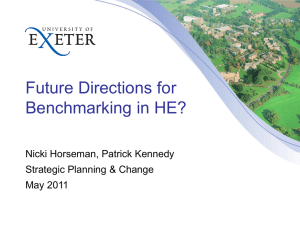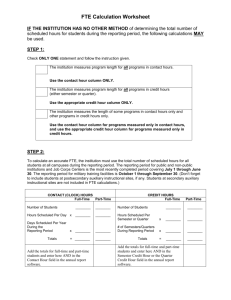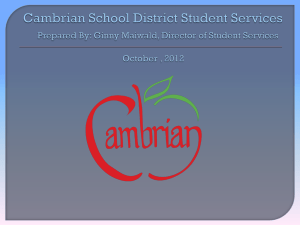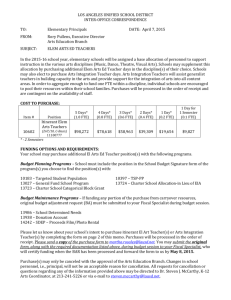Library Budget Review Report
advertisement
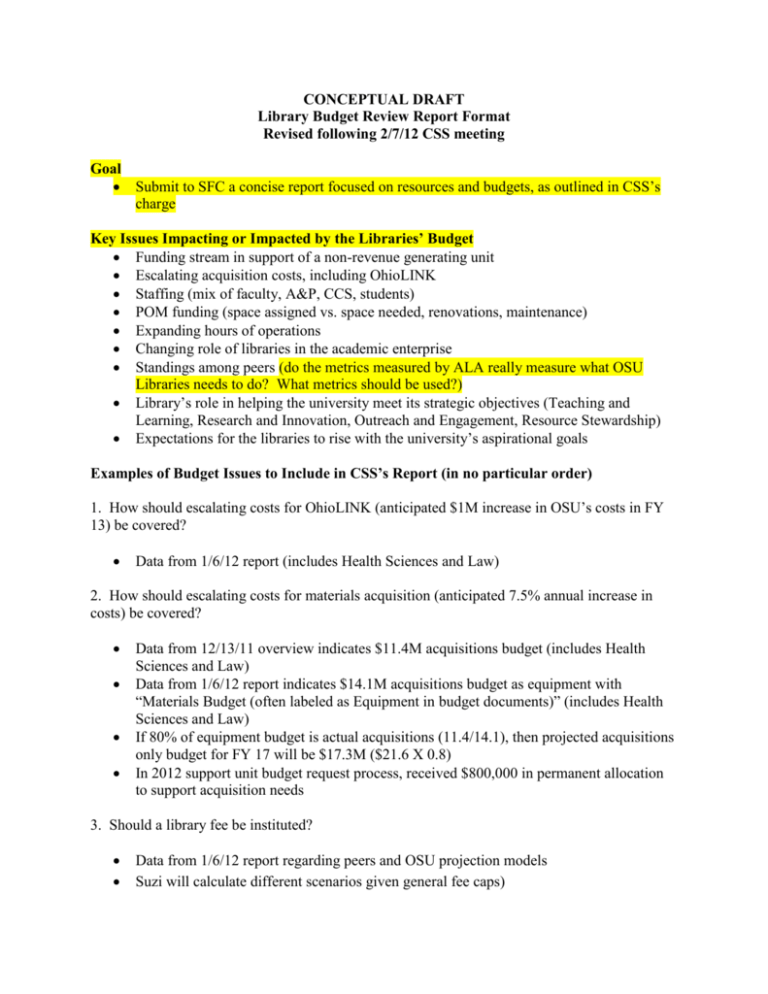
CONCEPTUAL DRAFT Library Budget Review Report Format Revised following 2/7/12 CSS meeting Goal Submit to SFC a concise report focused on resources and budgets, as outlined in CSS’s charge Key Issues Impacting or Impacted by the Libraries’ Budget Funding stream in support of a non-revenue generating unit Escalating acquisition costs, including OhioLINK Staffing (mix of faculty, A&P, CCS, students) POM funding (space assigned vs. space needed, renovations, maintenance) Expanding hours of operations Changing role of libraries in the academic enterprise Standings among peers (do the metrics measured by ALA really measure what OSU Libraries needs to do? What metrics should be used?) Library’s role in helping the university meet its strategic objectives (Teaching and Learning, Research and Innovation, Outreach and Engagement, Resource Stewardship) Expectations for the libraries to rise with the university’s aspirational goals Examples of Budget Issues to Include in CSS’s Report (in no particular order) 1. How should escalating costs for OhioLINK (anticipated $1M increase in OSU’s costs in FY 13) be covered? Data from 1/6/12 report (includes Health Sciences and Law) 2. How should escalating costs for materials acquisition (anticipated 7.5% annual increase in costs) be covered? Data from 12/13/11 overview indicates $11.4M acquisitions budget (includes Health Sciences and Law) Data from 1/6/12 report indicates $14.1M acquisitions budget as equipment with “Materials Budget (often labeled as Equipment in budget documents)” (includes Health Sciences and Law) If 80% of equipment budget is actual acquisitions (11.4/14.1), then projected acquisitions only budget for FY 17 will be $17.3M ($21.6 X 0.8) In 2012 support unit budget request process, received $800,000 in permanent allocation to support acquisition needs 3. Should a library fee be instituted? Data from 1/6/12 report regarding peers and OSU projection models Suzi will calculate different scenarios given general fee caps) 4. Are there efficiencies to be realized by combining personnel, technical services, or other elements of the University Libraries, Prior Health Science Library, and Law Library? Staffing data from 12/13/11 overview and 1/6/12 report “Sources and Uses” documents for the three libraries posted at: http://www.rpia.ohiostate.edu/committees/senfiscal/css/index.html University Libraries Staffing FTE Employee Group Faculty FTE Staff FTE Total FTE 2004 53.9 154.78 208.68 2005 55.9 154.76 210.66 2006 58.45 162.13 220.58 2007 61.75 165.15 226.9 2008 61 174.65 235.65 2009 59 172.55 231.55 2010 58.5 168.05 226.55 2011 56 157.3 213.3 2005 5.95 26.41 32.36 2006 6 32.9 38.9 2007 7 25.95 32.95 2008 8 29.07 37.07 2009 5 31.05 36.05 2010 6 28.25 34.25 2011 7 35.5 42.5 2005 18.75 18.75 2006 17 17 2007 18 18 2008 16.8 16.8 2009 15.8 15.8 2010 15.84 15.84 2011 13.85 13.85 2006 64.45 212.03 276.48 2007 68.75 209.1 277.85 2008 69 220.52 289.52 2009 64 219.4 283.4 2010 64.5 212.14 276.64 2011 63 206.65 269.65 Health Sciences Library Staffing FTE Employee Group Faculty FTE Staff FTE Total FTE 2004 7.3 17.25 24.55 Law Library Staffing FTE Employee Group Staff FTE Total FTE 2004 18.75 18.75 Total Ohio State Libraries Staffing FTE Employee Group Faculty FTE Staff FTE Total FTE 2004 61.2 190.78 251.98 2005 61.85 199.92 261.77 5. What is the budget impact of greater utilization and expanded operating hours and how are these costs being covered? Data from 1/6/12 report (FY12 $1.7M, estimate for FY 17 $2.7M) In 2012 support unit budget request process, received $200,000 in permanent allocation to support expanded hours 6. Is there excess space being used by the libraries that is costly and could be used in other ways by other units, relieving the Libraries budget of unnecessary POM costs? Space allocation summary from 1/6/12 report 7. Are there budget or administrative efficiency ramifications for having the Libraries as the TIU for Prior Health Sciences Library (and Law????) but not having administrative control over those libraries? How to determine? “Sources and Uses” documents for the three libraries posted at: http://www.rpia.ohiostate.edu/committees/senfiscal/css/index.html 8. What is the appropriate staffing level for the Libraries (compared to peers, according to ALA student/staff ratio standards, etc.) and what would be the cost of increasing staffing to meet these markers? Do surveys show dissatisfaction with service? What is the right mix of staff—faculty, A&P, CSS, students—given their roles? What is the mix of staffing compared to OSU’s aspirational peers? Data from 1/6/12 report (salaries FY 12 $18.3M, projected for FY 17 $24.6M) “Sources and Uses” documents for the three libraries posted at: http://www.rpia.ohiostate.edu/committees/senfiscal/css/index.html Faculty FTE Staff FTE, A&P Staff FTE, CCS Grad Stu FTE Stu FWS FTE Stu wages FTE Total FTE # 63 35 137 10 67 104 416 2006 % 15.1% 8.4% 32.9% 2.4% 16.1% 25.0% Library Personnel (excluding Health Sciences and Law) 2007 2008 2009 2010 2011 # % # % # % # % # % 61 15.1% 60 15.3% 62 15.9% 58 15.5% 56 16.1% 53 13.1% 57 14.5% 61 15.6% 61 16.4% 60 17.3% 131 32.3% 127 32.3% 114 29.2% 106 28.4% 102 29.4% 9 2.2% 11 2.8% 10 2.6% 9 2.4% 8 2.3% 42 10.4% 34 8.7% 53 13.6% 80 21.4% 64 18.4% 109 26.9% 104 26.5% 90 23.1% 59 15.8% 57 16.4% 405 393 390 373 347 9. Can current alternative sources of revenue be enhanced, or new ones exploited, to provide additional revenue? Possibilities include: Trademarks and Licensing (currently receiving about $600K of total $790K trademark allocation receipts, according to 12/13/11 overview), other affinity relationships, room rentals (11th floor, others), income from copiers/printers/coffee shop, etc., others? “Sources and Uses” documents for the three libraries posted at: http://www.rpia.ohiostate.edu/committees/senfiscal/css/index.html
